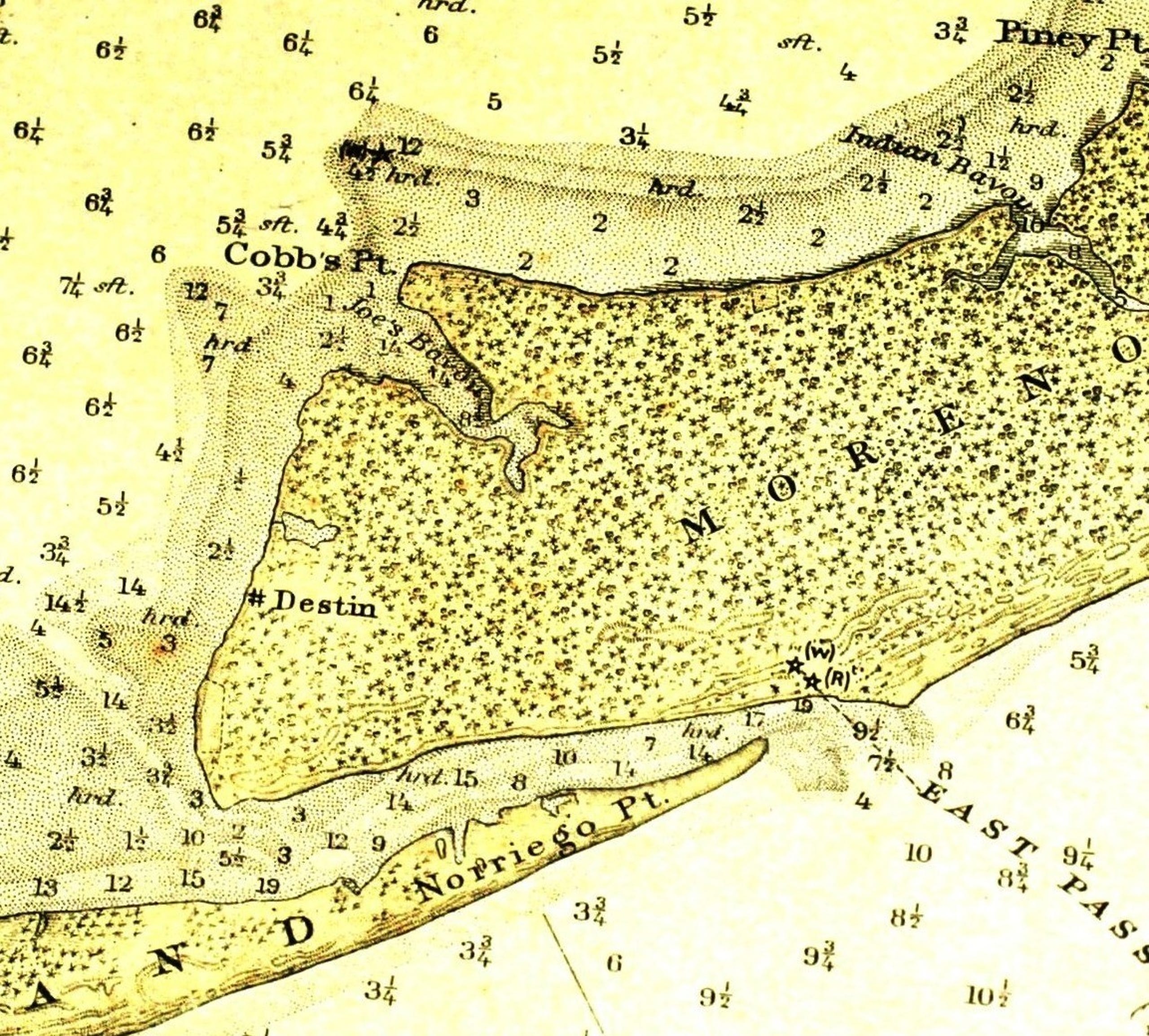This is a 1916 nautical chart of Norriego Point, East Pass, and Moreno Point.
Visualization in the GeoGarage platform (NOAA nautical raster chart)
You may have heard that the old East Pass entrance was at the east end of what is today the Destin Harbor between Sandpiper Cove Condominiums and the Pelican Beach Resort.
While that is true, did you know there were range lights at the entrance to the old East Pass?Our History Mystery this month is those range lights and their light keepers.
The 1916 nautical chart shows Norriego Point at the end of Santa Rosa Island to the lower left on the chart.
On the middle right of the chart is the entrance to the old East Pass.
Notice the two stars on the land mass.
Those are a pair of range lights used to help locate and navigate the old East Pass.
Notice (R) which means red, and the (W) which means white.
Those were the colors of the range lights.
The range lights stood six feet above the mean high-water line.
The red front range light was 30 feet high, while the white rear range light was 40 feet high.
The piles the range lights were mounted on were 12” by 12” square, yellow pine timbers.
Also notice the broken line extending from the lights (------).
That indicates the line of sight used to line up the entrance to East Pass.
Actually, the lights were mounted at the top of range dayboards.
These are a pair of rectangular boards and lights that are designed to guide mariners through hard-to-enter inlets like the old East Pass.
The old East Pass was narrow, winding, and in some places shallow.
Mariners who entered the old East Pass, from the Gulf of Mexico, often needed visual guidance to find the entrance, especially at night.
Range dayboards and lights provided that guidance.
Range dayboards/lights are built on land, one behind the other.
The forward light is lower while the rear light is higher.
When the two lights (or dayboards) are lined up they form a range to indicate a safe route or centerline of the channel.
Range lights had to be maintained and lighted, then relighted when the kerosene ran out.
This was the job of the light keeper who was employed by the United States Lighthouse Board, an agency of the US Treasury before it was merged into the United States Coast Guard in 1939.
This is an example of range dayboards/lights from Nantucket Harbor, Massachusetts Range Light
The Office of the Lighthouse Engineer in Mobile, Alabama, issued a contract to build and erect the range lights at East Pass to J. H. Gardner of Dalton, Georgia, on Oct. 12, 1897.
The contract called for the work to be completed within four months after acceptance of the contract.
According to the publication Keepers of Florida Lighthouses 1820-1939 by Neil E. Hurley, the first light keeper of the Choctawhatchee East Pass Range Beacons was Clairmon (Clement) Brooks, who was the light keeper until August 1901.
On Aug. 12, 1901, Alfred Destue (Destin) was hired by the Light House Board as the light keeper.
He worked until June 23, 1902, and earned an income of $350 a year.
Alfred Destin was the youngest son of Leonard and Martha Destin, the founders of the fishing village of Destin.
Upon Alfred Destin’s departure in 1902 William T. Marler took over as the light keeper at a salary of $350 a year.
Marler continued as light keeper until September 1910.James W. Ward took over as light keeper on Sept. 1, 1910, at a salary of $450 a year.
There is no record of any other light keeper.
The new East Pass was cut through Norriego Point in March 1929, and after that, there was no need to continue to use the old East Pass.
So, there was no longer a need for the range lights or the light keepers.
Links :




No comments:
Post a Comment